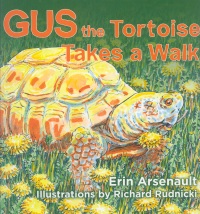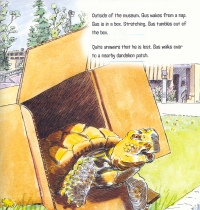| ________________
CM . . . . Volume XIX Number 9 . . . . November 2, 2012
excerpt:
Since 1940, Gus the gopher tortoise has been a long-time resident of the Nova Scotia Museum of Natural History in Halifax. His habitat is in the foyer of the museum. Children who come to the museum almost always make a visit with Gus their first stop. Though his new habitat has an acrylic cover to protect him from constant patting, he is still taken out at feeding time, and children who are at the museum then may touch him. In summer, he also goes for walks on the lawn behind the museum. Once he escaped and had travelled two blocks toward the Public Gardens before he was found. Gus has a huge following of children and adults and his 90th birthday was recently celebrated with a party at the museum.
Gus starts on the lawn behind the museum, travels past the horses of the Junior Bengal Lancers, hears the noon gun from Citadel Hill, then goes over to the corner of Spring Garden Road and Summer Street to cross the road with the girls going back to Sacred Heart School. He then wends his way down to the commercial area of Spring Garden Road where he listens to a street musician. He makes his way to the Public Gardens where he is chased by a goose, visits the band stand and duck pond, before coming to rest by a fountain. Elliot is portrayed as searching "through every bush and down every alley. He finds lost cats. He finds lost dogs. He even finds a lost parakeet, but no lost tortoises." Elliot finds time to make signs and post them along Spring Garden Road. Finally in despair and contemplating phoning the curator to report that Gus is lost, Elliot wanders through the Public Gardens and, as he tosses some pennies into a fountain to wish for Gus's return, spots a strange rock that begins to move. Gus is found. Erin Arsenault has taken the idea of Gus's new habitat and the story of Gus's escape and has woven them into her story of Gus's adventures in the Spring Garden Road / Public Gardens area of Halifax. She has added characters, such as Miriam, the crossing guard at Sacred Heart School, and Maurice, the street musician, to give a colourful picture of this dynamic area of Halifax. Her language varies from the straightforward -- "Gus wakes from a nap. Gus is in a box. Stretching, Gus tumbles out of the box." -- to the whimsical -- "Maurice plays with his heart open and his eyes closed, so he does not notice the tortoise walk by, but the trumpet plays a smooth and slow tune. Like a tortoise trot." She uses repeated phrases "Where could Gus be?" and "Gus continues on his way." Perhaps because these phrases alternate, they do not gain the momentum to become a chorus for the audience when the story is read aloud. The illustrations by Richard Rudnciki add colour and zest to the story, providing a visual reference for places that would otherwise need more written description. However, the colour palette is strongly dominated by yellow, which, though it gives a sunny feel and is fine for Gus, sometimes leaves the people looking jaundiced. The quality of the illustrations is uneven. In some illustrations, Gus is a fully rendered character with personality and expression; in others, he is cartoonish. Elliot would not be recognizable on some pages except for his blue shirt and shorts and the text references, and in the next-to-last illustration, in which he finds Gus, his expression is downright scary rather than happy. This book was pleasing to my test audience – grades 1-6 in an elementary school approximately seven blocks from the museum. All of the students were familiar with Gus and the locales. They enjoyed the story and were happy to make connections to their experiences of Gus and the museum. Though Gus the Tortoise Takes a Walk may be primarily of local interest, it would also be a good purchase for visitors looking for a remembrance of Halifax to take home. The cover is especially colourful and appealing. Recommended. Rebecca King is a Library Support Specialist with the Halifax Regional School Board in Halifax, NS.
To comment
on this title or this review, send mail to cm@umanitoba.ca.
Copyright © the Manitoba Library Association. Reproduction for personal
use is permitted only if this copyright notice is maintained. Any
other reproduction is prohibited without permission.
NEXT REVIEW |
TABLE OF CONTENTS FOR THIS ISSUE
- November 2, 2012.
AUTHORS |
TITLES |
MEDIA REVIEWS |
PROFILES |
BACK ISSUES |
SEARCH |
CMARCHIVE |
HOME |

 Gus the Tortoise Takes a Walk, by Erin Arsenault, occurs on the day Gus was moved into his new habitat. Elliot, a young man employed by the museum, is in charge, and, after rushing around with boxes, he finds that Gus has disappeared. The story follows both Gus's travels and Elliot's attempts to find Gus.
Gus the Tortoise Takes a Walk, by Erin Arsenault, occurs on the day Gus was moved into his new habitat. Elliot, a young man employed by the museum, is in charge, and, after rushing around with boxes, he finds that Gus has disappeared. The story follows both Gus's travels and Elliot's attempts to find Gus.